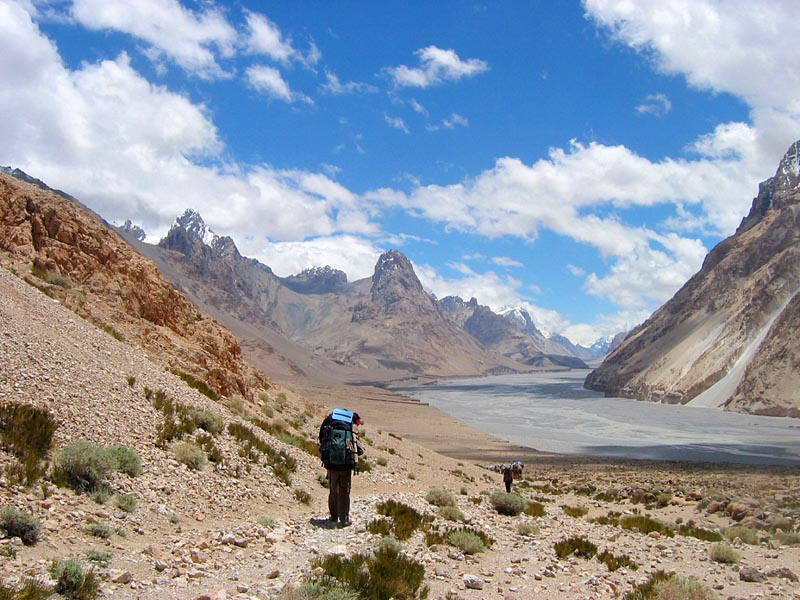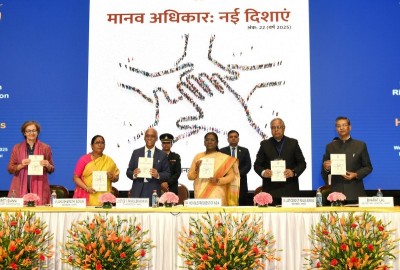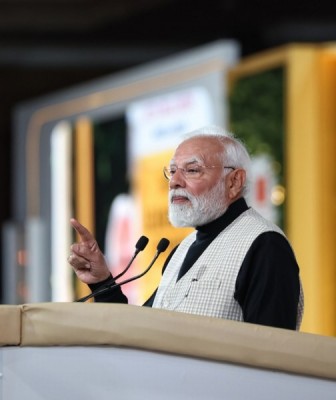 Kashmir
Kashmir
Construction of military infrastructure by China in Shaksgam Valley of Jammu and Kashmir ceded illegally by Pakistan, violates international law
The Shaksgam Valley, also known as the Trans Karakoram Tract, is part of Hunza-Gilgit region of the erstwhile princely State of Jammu & Kashmir (J&K), which, following the accession of J&K to India on October 26, 1947, legally became a part of India.
India, however, did not exercise physical control over Shaksgam Valley due to the forcible occupation by Pakistan of large parts of the erstwhile princely State, including the Shaksgam Valley, and which territories are today collectively referred to as Pakistan-Administered J&K.
Shaksgam Valley bordered the Xinjiang Province of China to the north, the Northern Areas of Pakistan-Administered J&K to the south and west, and the Siachen Glacier to the east.
However, in 1963, Islamabad, despite not possessing any legal title over this area, formally ceded the Yarkand River and Shaksgam Valley to Beijing.
Conveniently glossing over the disputed nature of the territory, China betrayed no qualms about illegally taking over and setting up shop in a region over which the ceding party had no legal authority or sanction to do so.
Recent reports suggest that China, much to the chagrin of India, has now intensified construction of military infrastructure and roads in Shaksgam Valley. Such construction is causing a region that at least legally ought to be Indian territory to ironically become a source of security concern for it instead.
China started asserting its territorial claims on the frontiers of the Jammu & Kashmir State in the late 1950s. Chinese troops had started entering into territories in eastern Hunza from 1953.
In October 1959, Pakistani media reported illegal intrusion of Chinese troops into lands claimed by the Mir of Hunza.
This prompted the then foreign minister of Pakistan to react sharply, stating that Pakistan would defend its frontiers by all possible means.
In the late 1950s, with relations between India and China undergoing a sharp deterioration, Pakistan’s then President Ayub Khan sensed an opportunity to appease China in order to externally balance souring relations with India.
In the face of the Chinese ingress into the Hunza Valley, he chose to open a line of communication with Beijing to discuss the border issue. In May 1960, Pakistan revealed that it had decided to negotiate the border issue with China.
On January 15, 1961, the Pakistan Foreign Minister revealed to the media that China had agreed in principle to demarcate its boundary with Pakistan and that talks in this regard were in progress.
By the end of May 1961, the essential contours of the agreement started taking shape, even as Beijing kept assuring India that China had not discussed anything with Pakistan until then.
Former Indian diplomat Sujan R. Chinoy described the tone and tenor of the China-Pakistan talks when he wrote in November 2020 that “Over the two years of negotiations, Pakistan came out with unconvincing and self-serving logic to systematically downgrade the historical claims of the Mir of Hunza in order to pave the way for conceding the territory in question to China.
Maps with maximalist claims were exchanged between the two sides in early 1962.
Ironically, the map produced by the Survey of Pakistan, which showed the Shaksgam Valley and parts of Xinjiang within POK, was later disowned by the Pakistani leadership who held that the concerned institution had no authority to draw the line of an undefined border on the map!
It was equally interesting that the Chinese withdrew their map after Pakistan agreed to concede more strategic territories in the trans-Karakoram tract than had earlier been claimed by the Chinese.
The benefits to Pakistan flowed immediately thereafter. By May 1962, China had decided to take a position on Kashmir that was much closer to that of Pakistan. On May 31, 1962, for the first time, the Indian Embassy in Beijing was informed through a ‘Note’ that China had never accepted ‘without reservation’ the position that Kashmir was under Indian sovereignty… China became a direct party to the Kashmir issue both by concluding the 1963 agreement with Pakistan and taking the trans-Karakoram tract and, earlier, by occupying Aksai Chin”.
Explaining the 1963 boundary agreement, Pakistan’s then Foreign Minister Zulfikar Ali Bhutto said, “It is a matter of the greatest importance that through this agreement we have removed any possibility of friction on our only common border with the People’s Republic of China. We have eliminated what might well have become a source of misunderstanding and of future troubles… An attack by India on Pakistan would no longer confine the stakes to the independence and territorial integrity of Pakistan. An attack by India on Pakistan would also involve the security and territorial integrity of the largest state in Asia”. Bhutto also told the United Nations Security Council (UNSC) that “Article VI of the Sino-Pakistan Boundary Agreement makes it clear that the Agreement is of a provisional nature between Pakistan and China, and that after the settlement of the Kashmir dispute, the sovereign authority that will emerge in Jammu and Kashmir, will reopen negotiations with the Government of the People’s Republic of China, so as to sign a formal boundary treaty to replace the present Agreement”. Despite the 1963 Agreement being conditional, it does not change the fact that it is of dubious legality.
Abhishek Trivedi, a columnist specializing in international law, pointed out in July 2019 that the 1963 boundary agreement was contrary to the rules of international law related to the right to self-determination as pronounced by the International Court of Justice (ICJ) in its advisory opinion on the Chagos Archipelago. He elaborated, “In the light of the law related to the right to self-determination as propounded by the ICJ above and the facts about the transferring of the territory of Shaksgam Valley to China, Pakistan has violated rules of international law applicable to the right to self-determination. The 1963 Agreement was concluded by Pakistan – an administrating power – in violation of the customary norms of self-determination. The agreement was not concluded with the ‘free and genuine will’ of the people of J&K. Thus, the detachment of 5,180 sq. km of the Shaksgam Valley by the 1963 Boundary Agreement was unlawful as the obligations arising under international law and reflected in UNGA resolution 1514 require Pakistan, as the administrating power in PoK (Pakistan-occupied Kasmir) region, to respect the territorial integrity of that region”. Trivedi also asserted that “By concluding the boundary agreement and ceding 5180 sq. km of Shaksgam Valley to China, Pakistan has not honored the territorial integrity of J&K which must be otherwise respected and protected to uphold the sanctity of international law… Pakistan cannot be legally allowed to argue from one side that it still believes in the self-determination of the people of J&K, but on the other side, that Pakistan may conclude an international agreement with a third country ceding a substantial territorial part of J&K to China”.
India has consistently maintained that under international law, the right of entering into treaties and agreements is an attribute of sovereignty. Furthermore, a sovereign cannot presume to exercise sovereign functions in respect of territory other than its own. Also, according to the terms of the UN Resolutions on J&K, “Pakistan cannot purport to exercise even ‘actual control’ over the defence of these areas”. A note of the historical division of India’s Ministry of External Affairs (MEA) has been quoted by the Indian media as stressing that “The conclusion of this ‘agreement’ amounts to compromising the sovereignty of the state of J&K, which Pakistan has no business to do”.
The 1963 agreement enabled the construction a decade later of the Karakoram Highway, an 810-mile road that cuts through the Khunjerab Pass in Gilgit-Baltistan (GB) in Pakistan-Administered J&K, towards Xinjiang in China. The Shaksgam Valley region has also been critical for the ‘Cooperation for the Long-Term Plan on the China-Pakistan Economic Corridor (CPEC)’ that was concluded in 2013, and Chinese President Xi Jinping visited Islamabad in April 2015 to flag off the CPEC.
It is in this backdrop that the Nepal-based online magazine Pardafas in a 7 June report titled ‘China-Pakistan collusion on Shaksgam Valley a threat to India’, revealed that “In the last several years, China has kept up military pressure on India, through its incursions across the Line of Actual Control (LAC). While this fact has been recognized by the international community, a recent study by Northwestern University shows that China’s incursions are strategically planned with the objective of making a permanent Chinese presence in these areas. Border transgressions and incursions are well documented in all three sectors of the 3,488 km long border that India officially shares with China.
However, far more sinister military aggression has been underway in Pakistan-Occupied Jammu and Kashmir (PoK).
Reference here is to the construction of military infrastructure and roads by China in the Shaksgam Valley, a trans-Karakoram tract ceded by Pakistan under the terms of the 1963 Boundary Agreement.
China’s traditional aggression across the LAC in fact diverts India’s attention from China’s illegal land grab in PoK, this is a strategic reality to be faced with in the medium future.
The China-Pakistan concert on the boundary in the Karakoram area of PoK (covering a distance of over 590 km) violates India’s traditional and legal rights in PoK. China has gone a step ahead and developed military infrastructure and roads in the disputed region, presenting a clear and present danger to India”.
The Hindustan Times reported on 9 April 2018 that satellite imagery of the region showed that China was changing the alignment of the Karakoram Highway, and that this could have strategic implications for India in the Daulet Beg Oldi and Siachen sectors, with the two all-weather friends sandwiching Indian positions.
Satellite images accessed by The Print on 15 January 2018 showed that China was building a road and military posts in the Shaksgam Valley. Google Earth satellite imagery of September and October 2017, and earlier, suggested that the road construction started probably after the Doklam stand-off in the India-Bhutan-China tri-junction area in mid-June 2017.
Pardafas added, “Chinese Border Defense personnel have also been observed patrolling the area along the newly constructed road in the Shaksgam region. At least two military posts are also visible now.
Older satellite imagery of 24 October 2016 shows no roads or posts in this entire area of Shaksgam Valley. Area maps clearly show that Rimo Glacier, Teram Shehr Glacier and the Siachen Glacier are located within the Indian union territory of Ladakh. The adjoining areas of these glaciers are PLA dominated territories like Shaksgam Valley and Yarkand Valley in the north and PoK in the west. By early 2019, the Indian media reported that the length of road constructed in Shaksgam Valley had reached 70 km”.
The Hindustan Times reported on 19 January 2022 that China and Pakistan were planning another road connecting Yarkand in Xinjiang to Muzaffarabad in Pakistan-Administered J&K through the Shaksgam Valley.
Pardafas concluded that even if Chinese activity in the Shaksgam Valley was not yet a direct military threat to Indian troops holding the Siachen Glacier, the People’s Liberation Army (PLA) actions could be considered “provocative”, and in the medium term could pose a military threat to Indian forces in Ladakh. It reminded that the PLA had a history of aggressive transgressions into what the Indian Army calls sub-sector north, and has consistently blocked Indian patrols in Depsang Bulge, south of DBO, with massive brigade-level deployments at Tein Wein Dein (TWD) across the Line of Actual Control (LAC). Opposite this sector, PLA troops from the Xinjiang Military District have carried out high-altitude live-fire assault ammunition training and military exercises in the Karakoram mountains at regular intervals. Satellite images also showed that Xinjiang’s Malan airbase was hosting an unmanned aerial vehicle (UAV) base.
Sujan R. Chinoy believes that on the basis of the 1963 boundary agreement, China has carefully nurtured Pakistan as a quasi-colony over the years. As Chinese power grew and that of Pakistan withered because of its self-defeating foreign and security policies, China found it easy to manipulate Pakistani leaders at will to strengthen its control over Pakistan. The Karakoram Highway and the China-Pakistan Economic Corridor both use this contested frontier to bring the two countries together in a closer embrace and help China build an alternative access to the Arabian Sea.
China’s disregard for international law while seeking to surreptitiously acquire, commercially exploit, and militarize sovereign territories of neighbouring countries, in this case territory that rightfully belonged to the erstwhile princely State of Jammu & Kashmir, which on 26 October, 1947 acceded to India, needs to be noted, highlighted, and robustly objected to by an international community that has thus far remained surprisingly silent on the matter despite its publicly professed desire to keep the increasingly boisterous China in check.
Support Our Journalism
We cannot do without you.. your contribution supports unbiased journalism
IBNS is not driven by any ism- not wokeism, not racism, not skewed secularism, not hyper right-wing or left liberal ideals, nor by any hardline religious beliefs or hyper nationalism. We want to serve you good old objective news, as they are. We do not judge or preach. We let people decide for themselves. We only try to present factual and well-sourced news.







